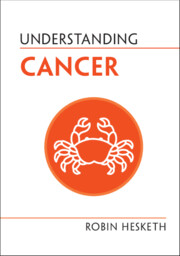Book contents
- Understanding Cancer
- Series page
- Understanding Cancer
- Copyright page
- Reviews
- Dedication
- Contents
- Foreword
- Preface
- Acknowledgements
- Gene Names
- 1 Painting a Clear Picture
- 2 Ancient History
- 3 Counting Cancer
- 4 From DNA to Protein
- 5 What Is a Cell?
- 6 Mutations
- 7 Causes of Cancer That Can be Controlled
- 8 Causes of Cancer That Are Difficult to Control, Accidents … and Other Things
- 9 Treating Cancer by Chemotherapy
- 10 The Road to Utopia?
- Concluding Remarks
- Summary of Common Misunderstandings
- References
- Figure Credits
- Index
6 - Mutations
Published online by Cambridge University Press: 17 May 2022
- Understanding Cancer
- Series page
- Understanding Cancer
- Copyright page
- Reviews
- Dedication
- Contents
- Foreword
- Preface
- Acknowledgements
- Gene Names
- 1 Painting a Clear Picture
- 2 Ancient History
- 3 Counting Cancer
- 4 From DNA to Protein
- 5 What Is a Cell?
- 6 Mutations
- 7 Causes of Cancer That Can be Controlled
- 8 Causes of Cancer That Are Difficult to Control, Accidents … and Other Things
- 9 Treating Cancer by Chemotherapy
- 10 The Road to Utopia?
- Concluding Remarks
- Summary of Common Misunderstandings
- References
- Figure Credits
- Index
Summary
In Chapter 5 we sketched the basic way in which cells process information from the outside world and the fundamental controls of the cell cycle. In principle, a mutation in any part that accentuates a positive or eliminates a negative could make a contribution to cancer. As a result of the amazing advances in DNA sequencing that we described in Chapter 4, we now know that most tumour cells accumulate tens of thousands of mutations, and so heterogeneous are tumours that every cell has a unique genome sequence. This implies that the longer you live, the more likely it is that a cancer will appear somewhere in your body – but the up-side is that two in every three only do so after the age of 60. Seventy-odd years ago the Finnish-born architect and amateur historian Carl Nordling drew a graph plotting the number of cancer deaths against the age at which they occurred. Result: a straight line. Remarkably, this holds true for pretty well every major cancer, regardless of country, sex or race.
- Type
- Chapter
- Information
- Understanding Cancer , pp. 76 - 102Publisher: Cambridge University PressPrint publication year: 2022

